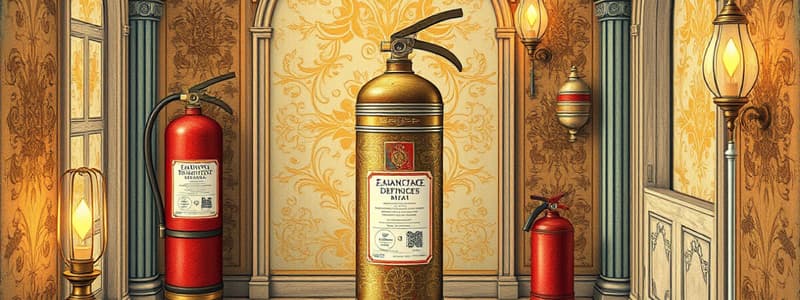Podcast
Questions and Answers
What is a Cartridge/Cylinder-Operated Fire Extinguisher?
What is a Cartridge/Cylinder-Operated Fire Extinguisher?
- A fire extinguisher with both gas and agent in the same container.
- A fire extinguisher that operates automatically.
- A fire extinguisher where the expellant gas is in a separate container from the agent storage container. (correct)
- A fire extinguisher that is intended to be used multiple times.
What does Nonchargable (Nonrefillable) Fire Extinguisher mean?
What does Nonchargable (Nonrefillable) Fire Extinguisher mean?
- A fire extinguisher that can be recharged.
- A fire extinguisher that can be filled multiple times.
- A fire extinguisher that is reusable.
- A fire extinguisher intended to be used one time. (correct)
What is a Portable Fire Extinguisher?
What is a Portable Fire Extinguisher?
- A handheld device containing an extinguishing agent. (correct)
- A large fire extinguisher that needs multiple people to operate.
- A fire extinguisher that requires electricity to function.
- A fire extinguisher that is fixed in one place.
What defines a Rechargeable (Refillable) Fire Extinguisher?
What defines a Rechargeable (Refillable) Fire Extinguisher?
What is a Self-Expelling Fire Extinguisher?
What is a Self-Expelling Fire Extinguisher?
What characterizes a Stored-Pressure Fire Extinguisher?
What characterizes a Stored-Pressure Fire Extinguisher?
What is the primary component of a Water Mist Fire Extinguisher?
What is the primary component of a Water Mist Fire Extinguisher?
What is a Water-Type Fire Extinguisher?
What is a Water-Type Fire Extinguisher?
What is the purpose of a Wheeled Fire Extinguisher?
What is the purpose of a Wheeled Fire Extinguisher?
What standards apply to Carbon Dioxide Fire Extinguishers?
What standards apply to Carbon Dioxide Fire Extinguishers?
What defines a Dry Chemical Fire Extinguisher?
What defines a Dry Chemical Fire Extinguisher?
What are some indicators of an Obsolete Fire Extinguisher?
What are some indicators of an Obsolete Fire Extinguisher?
What should Fire Extinguishers be marked with?
What should Fire Extinguishers be marked with?
What information should be provided on the label or tag of a fire extinguisher?
What information should be provided on the label or tag of a fire extinguisher?
Flashcards
Cartridge/Cylinder-Operated Fire Extinguisher
Cartridge/Cylinder-Operated Fire Extinguisher
Uses a separate gas cartridge to propel the fire-fighting agent.
Nonchargable Fire Extinguisher
Nonchargable Fire Extinguisher
A fire extinguisher designed for a single use and cannot be refilled.
Portable Fire Extinguisher
Portable Fire Extinguisher
A hand-held or wheeled device that expels fire-fighting agents under pressure.
Rechargeable Fire Extinguisher
Rechargeable Fire Extinguisher
Signup and view all the flashcards
Self-Expelling Fire Extinguisher
Self-Expelling Fire Extinguisher
Signup and view all the flashcards
Stored-Pressure Fire Extinguisher
Stored-Pressure Fire Extinguisher
Signup and view all the flashcards
Water Mist Fire Extinguisher
Water Mist Fire Extinguisher
Signup and view all the flashcards
Water-Type Fire Extinguisher
Water-Type Fire Extinguisher
Signup and view all the flashcards
Wheeled Fire Extinguisher
Wheeled Fire Extinguisher
Signup and view all the flashcards
Carbon Dioxide Fire Extinguisher Standards
Carbon Dioxide Fire Extinguisher Standards
Signup and view all the flashcards
Dry Chemical Fire Extinguisher Standards
Dry Chemical Fire Extinguisher Standards
Signup and view all the flashcards
Obsolete Fire Extinguisher Types
Obsolete Fire Extinguisher Types
Signup and view all the flashcards
Study Notes
Fire Extinguisher Types and Definitions
- Cartridge/Cylinder-Operated Fire Extinguisher: Uses an expellant gas stored separately from the agent.
- Nonchargable Fire Extinguisher: Designed for one-time use; cannot be recharged or restored.
- Portable Fire Extinguisher: Hand-held or wheeled device expelling agents under pressure to extinguish fires.
- Rechargeable Fire Extinguisher: Maintains full service with features like internal inspections and hydrostatic testing.
- Self-Expelling Fire Extinguisher: Contains agents that can expel themselves due to sufficient vapor pressure.
- Stored-Pressure Fire Extinguisher: Both agent and expellant gas in one container, includes a pressure indicator.
- Water Mist Fire Extinguisher: Employs distilled de-ionized water sprayed as a fine mist for fire suppression.
- Water-Type Fire Extinguisher: Contains water or foaming agents, including AFFF and wet chemicals.
- Wheeled Fire Extinguisher: Portable unit on wheels for easy transport by a single person.
Standards for Specific Fire Extinguishers
- Carbon Dioxide Fire Extinguishers: Complies with ANSI/UL 154 and CAN/ULC S503 standards.
- Dry Chemical Fire Extinguisher: Follows ANSI/UL 299 and CAN/ULC S504 standards.
- Water Type Fire Extinguisher: Aligned with ANSI/UL 626 and CAN/ULC S507 standards.
- Halon Fire Extinguisher: Meets CAN/ULC S512 standards for halogenated agents.
- Film-Forming Fire Extinguisher: Adheres to ANSI/UL 8 and CAN/ULC S554 standards.
- Halocarbon Fire Extinguisher: Complies with ANSI/UL 2129 and CAN/ULC S566 standards.
Marking and Labeling Requirements
- Fire extinguishers must display identification from listing and labeling organizations.
- Product categorization indicating the extinguisher type is required.
- Classifications (A, B, C, D, K) need to be clearly marked on the extinguisher.
- Standards for performance and fire testing met by the extinguisher must be included.
Identification of Contents
- Labels must include the product name as per the Material Safety Data Sheet (MSDS).
- Hazardous material identification must comply with HMIS or GHS.
- Information on hazardous substances over 1.0% and specific chemicals over 5.0% must be listed.
- Must include hazard details based on MSDS and contact information for the manufacturer or service agency.
Obsolete Fire Extinguishers
- Specific types of extinguishers must be removed from service, including:
- Soda Acid and Chemical foam extinquishers (non-film forming).
- Carbon tetrachloride, Methyl bromide, and chlorobromomethane extinguishers.
- Cartridge-operated water and loaded stream extinguishers.
- Certain old models of carbon dioxide extinguishers with metal horns.
- Additional obsolete units include solid charge AFF extinguishers, pressurized water extinguishers before 1971, and any needing inversion to operate.
Studying That Suits You
Use AI to generate personalized quizzes and flashcards to suit your learning preferences.




